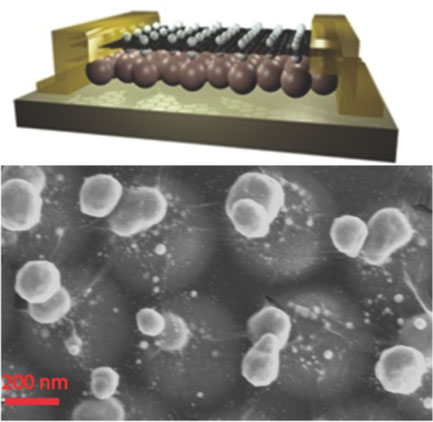| Posted: Mar 02, 2015 |
Silver nanoparticles adorn graphene to utilise light efficiently
|
|
(Nanowerk News) The most ubiquitous form of energy around us, light, is surprisingly underutilised. This is largely because photo-based devices are very inefficient at absorbing and then converting light into a useful electrical signal. Now researchers at the Indian Institute of Science (IIS) have designed a novel device based on graphene and metal nanoparticles that shows greatly enhanced response to light and is colour sensitive. This may foster applications like colour based ultra-sensitive photodetectors, efficient solar cells and detection of single molecules.
|
|
Increasing the light-matter interaction is one of the foremost scientific quests today. It holds the key to a wide range of contemporary pursuits like solar energy generation, hybrid light-electronic devices, cancer detection and many more. Many scientists have come up with numerous designs and methods to increase light absorption efficiency but much scope for improvement still remains.
|
|
Writing in the journal Advanced Materials ("Ultrahigh Field Enhancement and Photoresponse in Atomically Separated Arrays of Plasmonic Dimers"), the IISc team show a device with a large number of silver nanoparticle pairs sitting on top of each other, all separated precisely by just one-third of a nanometer using graphene. All light interaction related properties are found enhanced in this device structure. Photocurrent (current generated due to light), for example, generated in this device is 200 times more than in one without silver nanoparticles.
|
 |
| Combining oblique angle deposition with standard graphene transfer protocols, two planar arrays of metal nanoparticles are fabricated that are vertically separated by atomic dimensions, corresponding precisely to the thickness of a single layer of graphene, i.e., 0.34 nm. Upon illumination of light at an appropriate wavelength, the local electromagnetic field at the junction of the dimers can be increased dramatically, thereby resulting in the most sensitive graphene–plasmonic hybrid photodetector reported to date. (© Wiley)
|
|
Decorating a material with metal nanoparticles is a known way of increasing the interaction with light. When light falls on such tiny structures it forces all electrons to dance back and forth in a collective way, generating a very large electric field nearby. This large electric field extracts a response out of the material on which these metal nanoparticles rest. If there are two such nanoparticles close by, they interact and the electric field between them further increases. Researchers have tried to exploit this idea but with limited success due to the stringent requirement of separating the nanoparticles by just a few nanometers.
|
|
In the present work, graphene acts as a perfect spacer and this produces an unprecedented field enhancement of nearly a million times in between the nanoparticles, boosting the interaction with light. As a result, the Raman signal in this device was found to be 100 times more intense. (Raman Effect, whereby light is reflected by a material in a signature pattern, is routinely used to study graphene.) This is of significance because although graphene responds to a large range of light frequencies (colours) and has a very fast response, it does not absorb light very well by itself.
|
|
The authors also show that graphene may be irreplaceable, providing the optimum separation distance between nanoparticles, reducing the distance further may reduce the field enhancement. This design can be extended to other materials as well, Prof. Ambarish Ghosh who led the research says "The technique will allow a variety of plasmonic (metal nanoparticles) and 2D materials, which can be used to make devices of well designed functionality."
|
|
This interdisciplinary research included researchers from the Centre for Nano Science and Engineering, Department of Electrical Engineering and the Department of Physics. They are already looking for industrial partners to take this technique out of the lab and into applications. With more work the device may become well suited for applications like sensitive colour-based detection, efficient medical diagnosis and single molecule detection.
|

